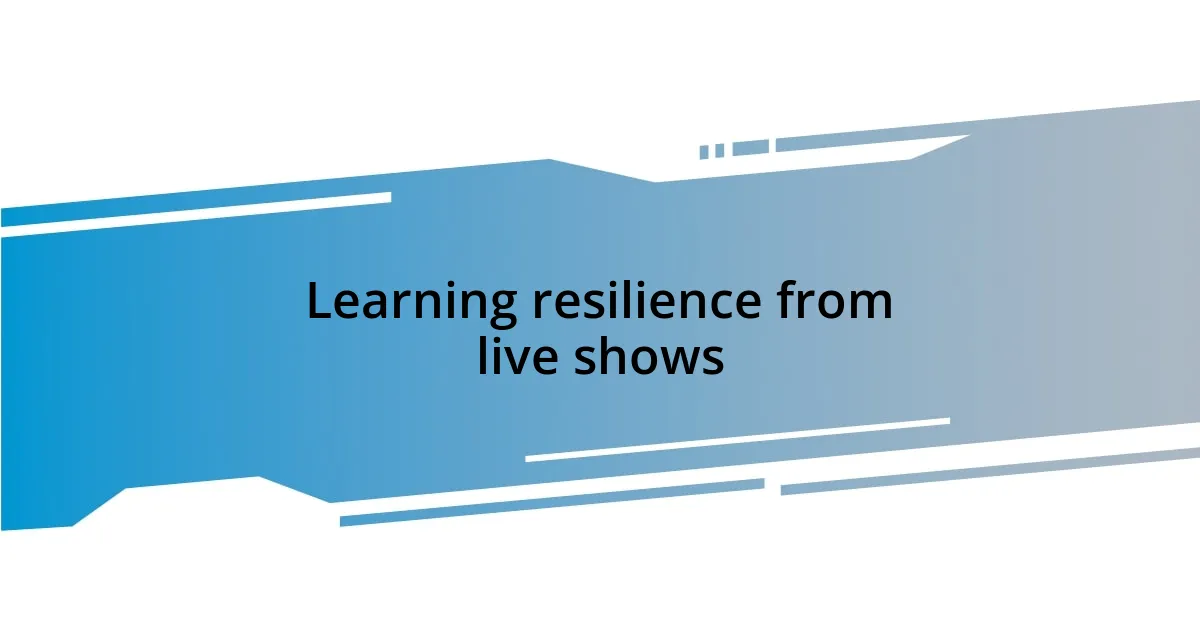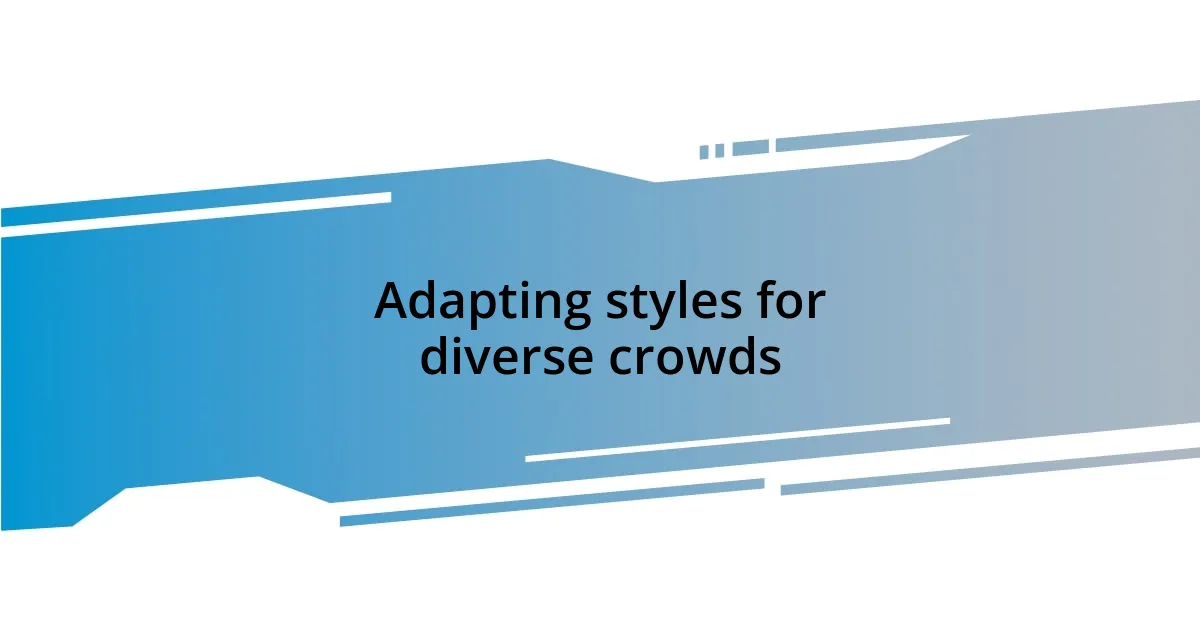Key takeaways:
- Performers have the ability to evoke deep emotions and create connections, transforming audiences’ experiences into shared moments.
- Creativity in performances reflects personal experiences and cultural backgrounds, making each act unique and engaging.
- Resilience is a crucial trait for performers, allowing them to adapt and turn setbacks into opportunities for connection and engagement.
- Adapting styles and incorporating audience interaction fosters inclusivity and strengthens community bonds during performances.

Festival performers and their influence
As I’ve immersed myself in various festivals, I’ve noticed how performers possess an uncanny ability to evoke emotions in every spectator. I remember standing in the crowd, completely mesmerized by a fire dancer whose movements seemed to tell a story of passion and resilience. How can one person wield such power over a sea of faces? Their art forms aren’t just entertainment; they ignite connections and create shared experiences.
Think about the impact of musicians like a folk band playing under a starlit sky. In those moments, the melodies weave through the audience, sparking memories and emotions that resonate deeply. I recall singing along, surrounded by strangers who, at that moment, felt like family. Isn’t it fascinating how music can break down barriers and unite diverse groups of people?
Beyond the stage, performers often serve as catalysts for change. I’ve seen poets at festivals use their words not just for expression but as a call to action, urging listeners to reflect on social issues. Through their passionate performances, they challenge the status quo and inspire people to think critically. Can one performance really create a shift in perspective? From what I’ve witnessed, it absolutely can.

Understanding performer creativity
Understanding performer creativity is like peering into a world where imagination knows no bounds. Each artist brings their unique interpretation, a blend of personal experiences, culture, and emotion that shapes their creative expression. I remember watching an aerialist whose fluid movements reminded me of water flowing through a stream. It dawned on me that their creativity was a reflection of their journey—every twirl and dip telling a story that transcended words.
Here are some key aspects of performer creativity to consider:
- Personal Expression: Performers channel their life experiences into their art, making each performance a piece of their identity.
- Emotional Resonance: Creativity evokes feelings; a single note can conjure joy, sadness, or nostalgia.
- Cultural Reflection: Many performances reflect the artist’s cultural background, providing a glimpse into diverse traditions.
- Innovation and Risk: Creative performers often push boundaries, experimenting with new styles that challenge conventions.
- Audience Interaction: They adapt their energy based on audience reactions, creating a dynamic and shared experience.
In my encounters with street performers, I’ve witnessed their ability to reinvent classic acts with fresh perspectives. For instance, a juggler at a local fair incorporated humor and storytelling into their routine, leaving spectators not just impressed but deeply entertained. Watching him, I realized that every creative choice—from the music to the movement—was deliberate, aimed at forging a connection. Isn’t it awe-inspiring how these moments of spontaneity bring us together as a community?

The power of audience connection
Every time I step into an audience at a festival, I can feel the electric energy in the air. It’s as if performers possess an innate ability to read the crowd, adjusting their energy and vibe based on who stands before them. I remember a moment during a particularly mesmerizing drum circle where the beat seemed to pulse through my body, making connections with others around me. It was less of an individual experience and more of a shared heartbeat, a reminder that we were all in this together.
The beauty of audience connection lies in the way it fosters a sense of belonging. I once watched a spoken word artist engage the crowd with powerful verses about identity and struggle. As she recited her poem, I saw tears glisten in the eyes of those around me. In those few minutes, it became clear that her words were not just hers; they resonated with everyone listening, acting as a mirror reflecting our collective experiences. Can anyone really remain untouched in such a moment?
As performers break down the barrier between stage and audience, they invite participation and co-creation. I had the chance to join in a dance circle during a festival, feeling the rhythm pull me in. Each move shared with strangers transformed us into a community, if only for a fleeting moment. Isn’t it incredible how a dance, a song, or a poem can foster such profound connections, leaving lasting memories?
| Aspect | Audience Connection |
|---|---|
| Emotional Impact | Transforms individual feelings into shared experiences |
| Catalyst for Interaction | Creates opportunities for audience participation |
| Sense of Belonging | Fosters connections among diverse groups |
| Memorable Moments | Leaves lasting impressions through collective engagement |

Techniques to engage through performance
Engaging an audience through performance often hinges on the power of storytelling. I once attended a theatrical piece where the performer not only acted but invited the crowd into their narrative. They paused frequently to ask us questions, prompting moments of self-reflection. Watching us respond, I realized how seamlessly this technique bridged the gap between artist and observer, making us active participants in the story unfolding before us. Isn’t it fascinating how a well-placed question can spark deep engagement?
In another instance, I witnessed a magician who used humor to create a relaxed atmosphere. His light-hearted banter drew chuckles and built anticipation as he set up each trick. I found myself leaning forward, eager to see the next surprise. This technique demonstrates that when performers can embrace vulnerability and laugh with their audience, they establish stronger connections. Have you ever noticed how laughter can be a universal language that brings everyone together, even for just a moment?
Moreover, incorporating physical movement can be a transformative way to engage an audience. At a festival, I watched a dancer use her entire body to convey emotions so powerful that they reverberated through the crowd. As she twisted and turned, I felt her passion resonate in my own heart, compelling me to join in her rhythm. This use of movement not only captivates but encourages the audience to feel something deep and personal. Isn’t it remarkable how a simple act of dance can invite others to open up and share in that emotional experience?

Learning resilience from live shows
Resilience in live shows often reveals itself through unexpected moments. I once witnessed a band lose power during a performance. Instead of faltering, the lead singer turned it into a spontaneous acoustic set, inviting audience members to sing along. This quick pivot not only salvaged the show but also created a shared experience of joy amid chaos. Isn’t it inspiring how performers can turn setbacks into opportunities for deeper connection?
Then there’s the way performers tackle their own vulnerability. I remember watching a singer who shared her battle with anxiety before launching into a heartfelt song. Her honesty resonated deeply, showcasing how courage can manifest in art. It made me realize that resilience doesn’t mean hiding our struggles; rather, it means embracing them and using them to fuel our creative expression. How often do we shy away from vulnerability in our own lives?
Another vivid memory comes from a street performer juggling fire. Despite the high stakes, he maintained a calm focus, embodying the idea that resilience often lies in composure. When a moment of clumsiness almost led to a stumble, he laughed it off and carried on, bringing the audience along for the ride. Watching him navigate that uncertainty reminded me that resilience is about staying true to oneself, even when things don’t go as planned. Can you remember a time when you faced a challenge with a light-hearted attitude?

Adapting styles for diverse crowds
Adapting styles for diverse crowds is an art that performers master over time. I recall a festival where a folk band shifted gears mid-set, opting for a lively, upbeat tempo that had everyone on their feet. The transformation was palpable; you could almost feel people’s spirits rising in response to the new energy. Isn’t it amazing how adjusting the music style can spark such enthusiasm in a crowd?
Another experience stands out for me from a poetry slam I attended. One poet skillfully wove in references to the cultural backgrounds of the audience, resonating with listeners from all walks of life. I found myself leaning in, captivated by his ability to address our shared experiences, effectively uniting the crowd through familiar themes. Have you ever seen how such thoughtful adaptation can create a sense of belonging among diverse individuals?
Moreover, witnessing a DJ effortlessly blend various genres was a true lesson in inclusivity. As he spun tracks, he took cues from the crowd’s reactions, seamlessly transitioning from hip-hop to electronic and then a classic rock anthem. I recall the sudden outburst of excitement as everyone sang along—an incredible reminder that tailoring one’s approach can create an electrifying atmosphere that embraces everyone. Isn’t it fascinating how music can bridge gaps, acknowledging differences while uniting us in the joy of rhythm?

Applying lessons to personal growth
Embracing adaptability is another crucial lesson I’ve taken to heart from performers. I recall a moment during a dance performance when the lead dancer unexpectedly slipped but quickly transformed that mishap into an improvised move that flowed right into the choreography. Witnessing this grace under pressure sparked a realization in me: life’s surprises often invite us to be creative problem solvers. Have you ever considered how a small shift in perspective could turn a blunder into a breakthrough?
Performers often push their boundaries, and I remember a local artist who decided to sing in multiple languages during a show. The way he connected with different cultural backgrounds in the audience left me feeling enriched. It illustrated that stepping outside of our comfort zones not only promotes personal growth but also fosters connection with others. Isn’t it amazing how one person’s bravery can inspire those around them to explore new horizons in their own lives?
Lastly, I reflect on a mime artist I encountered, who conveyed emotions without a single word. His ability to communicate complex feelings through gestures reminded me of the power of non-verbal expression. It’s an enlightening lesson about the importance of listening—not just with our ears but with our hearts. Have you thought about how we can often express ourselves more authentically when we allow vulnerability to shine through?
















